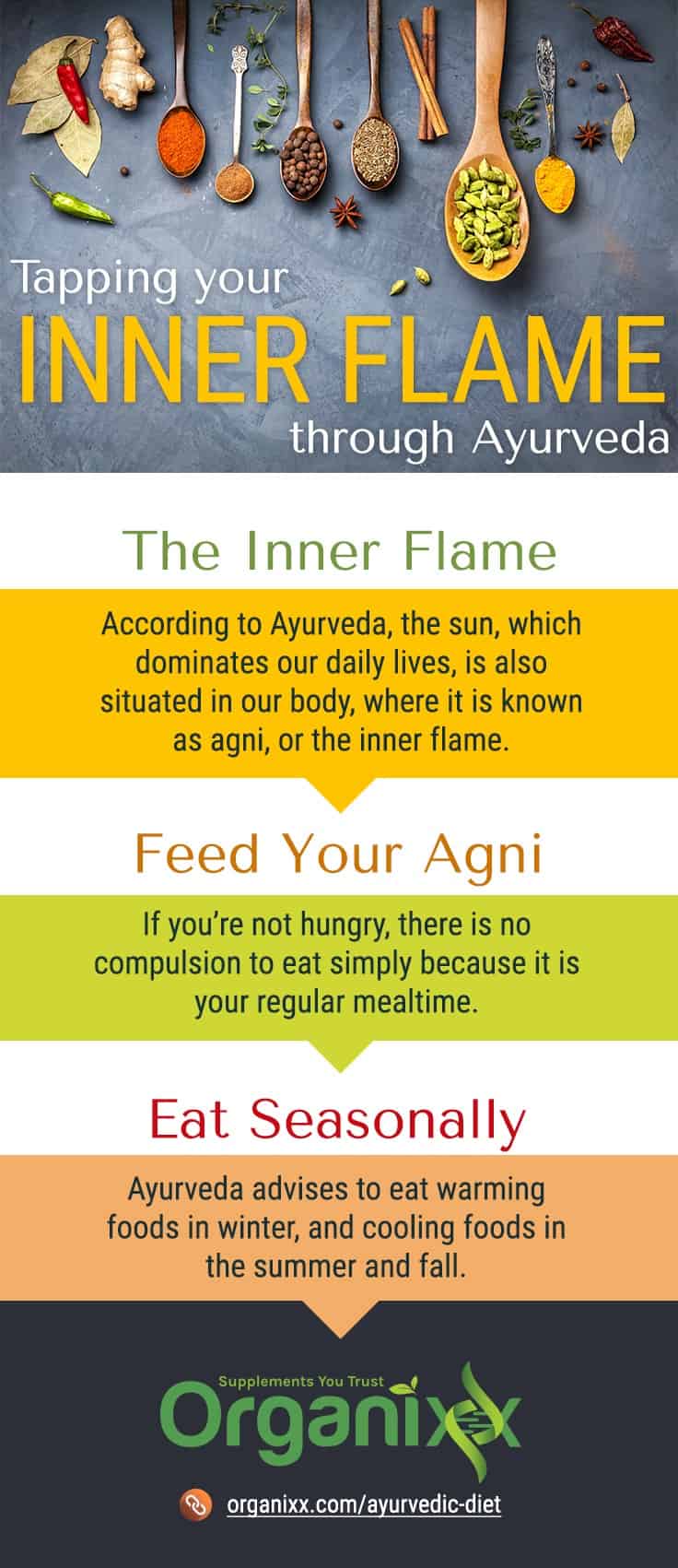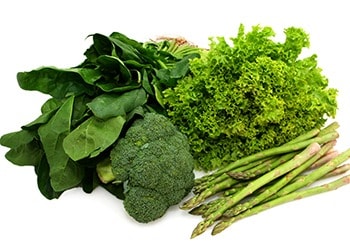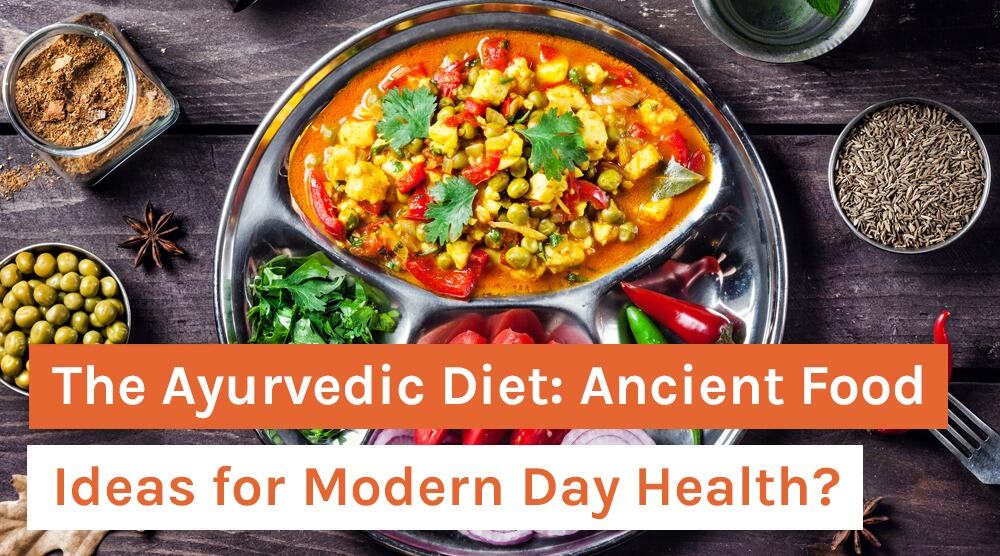The Ayurvedic Diet: Ancient Food Ideas for Modern Day Health?
In a hurry? Click here to read the Article Summary...
Ayurveda – literal meaning, the science of life (“Ayur” = life, “veda” = science) – is a highly evolved medical science that was developed in ancient India centuries ago. Ayurveda evolved into its modern form based on the detailed knowledge passed down in ancient treatises, especially the Atharvaveda – the so-called “knowledge storehouse of procedures for everyday life.” One interesting aspect of this ancient healing system are the principles of the Ayurvedic diet.
A Healthy Mind Leads to a Healthy Body
Ayurveda is not just another method of disease treatment. Practitioners describe it as an intricately conceived system of inner science that involves positive health and natural living. The goal of an Ayurvedic lifestyle is to harmonize ourselves with the greater Universe that exists within and around us.
Ancient Vedic literature clearly explains how we can maintain our health and well-being through the judicious use of therapies, massages, herbal medicines, diet control (e.g., mindful eating), and exercise.
According to this traditional system, a healthy mind leads to a healthy body. What we think affects how we physically feel – while what we eat and drink cannot fail to have a profound effect on our mind.
Specifically, the ancient Vedic concepts of sattva (purity and balance), rajas (agitation), and tamas (inertia) are considered to be the three forms of mind-based consciousness that deliver many health benefits (more on this later).
Why Food Is So Important in Ayurvedic Medicine
Interestingly, according to the principles of an Ayurvedic diet, food provides much more than physical sustenance for the body or something to be manipulated for weight loss. Indeed, food is thought to shape and shift the mind, influencing both the ability to think and even deep emotions.
When food is consumed mindfully and with reverence, the body is believed to become filled with health, serenity, vitality, hope, and joy. This concept of spiritually charged foods is unique to Ayurveda and sets it apart from all other dietary systems.
Let’s take a look at how Ayurveda classifies different foods based on the effects they are believed to have in the body.
The 3 Food Types That Affect the Body According to Ayurveda
1. Sattvic Foods
So-called “sattvic” foods are pleasing to the senses and nutritious, along with having a soothing effect on the mind and nerves.
Sattvic foods impart strength and stability and are believed to be full of “prana” (life force) and are typically light and easy to digest.
Ayurveda emphasizes the importance of eating sattvic foods to support both physical health and a peaceful state of mind. For food to be sattvic, it must be eaten in the right quantity, be balanced in its qualities, and always fresh.
Food is said to take on sattvic qualities when it is mindfully sourced and cooked with attention to freshness and hygiene, and consumed with gratitude and awareness – without speed, greed, or waste.
According to Ayurvedic diet tradition, sattvic foods should be cooked in ghee (clarified butter), with just enough fragrant spices added to enable optimum digestion. In general, plant-based foods are considered to be more sattvic than eggs, fish, and meat. Similarly, simply cooked foods are more sattvic than overly processed and refined foods.
Nuts, seeds, raw honey, sweet whole fruits in season, many vegetables (including leafy greens, sweet potatoes, and most other root vegetables) and all-natural whole grains are all considered to be sattvic foods. In fact, seasonal awareness is very important in creating a sattvic diet.
2. Rajasic Foods
So-called “rajasic” foods overstimulate and irritate the body and mind, either due to their inherent or added properties such as excessive pungency, sourness, saltiness, heat (e.g., from chili peppers), sharpness (acidity), and dryness.
According to Ayurvedic diet principles, garlic is a naturally rajasic food, as are chilis and other spicy peppers. Processed, junk, and fast food as well as alcohol, caffeine, and recreational drugs are also considered to be rajasic in nature.
Even an otherwise healthy vegetarian diet cooked with too much salt and spices that is consumed along with caffeine, alcohol, and soda in a hurried manner while in an agitated frame of mind is believed to have rajasic effects on the body.
3. Tamasic Foods
So-called “tamasic” foods are believed to be detrimental for both mind and body, because they lack prana or the life force. This category includes foods that are stale, putrid, or excessively fatty and heavy.
For instance, while eating meat is recommended in Ayurveda to improve physical strength, a diet dominated by meat is believed to increase tamasic qualities. This is especially true when more than small amounts of cold, canned, and frozen meats are consumed. Instead, the Ayurvedic diet advises to consume freshly cooked organic meats in moderate quantities.
 Meal Planning: How You Eat Is Just as Important as What You Eat
Meal Planning: How You Eat Is Just as Important as What You Eat
All this doesn’t mean that Ayurveda automatically classifies all vegetarian foods as sattvic and all spices and garlic eaters as rajasic, and all meats and meat eaters as tamasic. After all, people have historically eaten the foods they eat due to geographical-cultural reasons, based on what foods were available to them.
Rather, Ayurveda states very clearly that it is the manner in which food is procured (ethically or not), cooked and consumed (mindfully or not) with other ingredients – whether old or fresh, calming, exciting, or dulling – that has the most impact on the body and mind.
Keeping Your “Inner Flame” Burning Bright Through Diet
According to Ayurveda, the sun, which dominates our daily lives, is also situated in our body, where it is known as agni, or the inner flame. If the sun were to disappear, all life would come to an end. Similarly, Ayurveda says that if our inner flame were to be extinguished, we would also die.
Not only our body, but even our mind is “fed” by the essence of the foods we consume, after they have been processed by agni.
Physical and mental strength, enthusiasm and courage, and especially longevity and overall health are all said to be directly related to the health of our agni.
According to Ayurveda, when our inner agni flickers and is variable, our health is affected. However, when this life-giving flame is steady and burns bright (but not too bright or out of control), we too become stable in both body and mind.
Ayurveda seeks to show how to maintain and protect the inner agni via the proper consumption of food and drinks in the right quantities and at the right times, keeping the seasonal effects of foods in mind.
The 6 Food Tastes of the Ayurvedic Diet
According to Ayurveda, the sense of taste is a natural guide to proper nutrition – if we are prepared to pay attention to it. Historically humans have long relied on their taste buds to discover healthy foods in nature and avoid toxic and poisonous foods. Not only that, our taste buds are essential for unlocking the nutritive value of foods and sparking the entire digestive process.
One way to find out what effect a particular food will have on the body is via its flavor or taste. Everything we eat has a specific taste, known as “rasa” in Sanskrit, which Ayurveda says affects the mind and body in specific ways.
This concept of taste applies not only to the perception of taste buds located on the tongue, but to the final reaction of food in the stomach.
The 6 Rasas (Tastes) in Ayurveda
- Madhur rasa (sweet) – starting with mother’s
 milk, this rasa tends to dominate our lives and our food culture.Ayurveda states that if we master the sweet taste and don’t allow ourselves to be mastered by it, we will have understood how to enjoy and engage with life without undue attachment.This rasa calms our nerves and mind, along with helping to build our body’s tissues. However, when consumed in excess, it induces a feeling of fullness and dulls our inner flame. It can be used to slow down and safely manage an out of control inner agni.
milk, this rasa tends to dominate our lives and our food culture.Ayurveda states that if we master the sweet taste and don’t allow ourselves to be mastered by it, we will have understood how to enjoy and engage with life without undue attachment.This rasa calms our nerves and mind, along with helping to build our body’s tissues. However, when consumed in excess, it induces a feeling of fullness and dulls our inner flame. It can be used to slow down and safely manage an out of control inner agni.
- Amla rasa (sour) – according to Ayurvedic diet principles, the body needs this rasa to stimulate and energize the body, but only in carefully measured quantities. Digestive stomach acid is an intrinsic aspect of our own inner agni. This rasa therefore stimulates digestion, along with cleansing the body and helping to absorb minerals and other micronutrients from our foods.
- Lavan rasa (salty) – when used in moderation, this rasa promotes the tastiness of our foods. In excess, salt is believed to harm the body’s tissues and cells, triggering harmful aging processes. According to Ayurveda, this rasa is both an appetite and digestive stimulant, along with lubricating the body’s tissues.
- Katu rasa (pungent) – this rasa is considered to be aggressive and combative, inflaming the inner agni and helping to cleanse the body when consumed in small and judicious quantities. However, pungent foods should ideally be consumed along with a sweet taste as a moderator, so that they do not inflame the inner agni too much, or too quickly, damaging health in the process.
- Tikta rasa (bitter) – dry, cooling, and light, this rasa is reputed to alleviate fevers and infections, remove toxins, clear out parasites, and heal the mind and body. When consumed in moderation, it is believed to support the inner agni.
- Kashaya rasa (astringent) – very rarely found in nature, this rasa is believed to prevent excessive secretion and leakage of bodily fluids – for example, during bleeding, diarrhea, and vomiting. In very low amounts this rasa counteracts excessive salivation, dries the body’s tissues and fats, and dampens the inner agni.
With an Ayurvedic diet the idea is to include all six tastes in every meal, if possible, since each taste feeds the mind, body, senses, and spirit in its own unique way. By including all six rasas in every meal, it is believed you can avoid food cravings and overconsumption of certain foods.
At the same time, there is no set formula on how to do this. Your unique constitution is the sole factor that determines the proportion of tastes you should consume. Ayurveda says that if you simply follow your natural inclinations, you will naturally be led to the proper foods that nourish you and keep you healthy.

A Closer Look at “Tikta” Rasa – the Bitter Taste
 According to Ayurvedic principles, this rasa is dry, cooling, and light in its properties, and supports the inner flame by imparting the quality of dryness.
According to Ayurvedic principles, this rasa is dry, cooling, and light in its properties, and supports the inner flame by imparting the quality of dryness.
In general, bitter tasting foods are cleansing for the body in moderate amounts. They soothe itching and burning sensations, reduce water retention, detoxify blood, and support liver health.
They also cleanse the taste buds and fight off parasites and other infections – which is why they are considered to be digestive tonics in Ayurveda when taken in moderation. They are also believed to relieve heaviness and dullness of body and mind.
However, if consumed in excess, these foods dehydrate the body and create gas and constipation.
Bitter tasting foods include: bitter melon, barley, grapefruit, olives, most leafy green and yellow vegetables including kale, Brussels sprouts, dandelion greens, nettle, jicama, spinach, endive, broccoli, cauliflower, asparagus, eggplant, neem, and the spices turmeric and fenugreek.
Turmeric Is a Therapeutic Agent of Ayurveda
Along with eating leafy green and yellow vegetables, one simple way to get the bitter taste into your diet is to add a pinch of fenugreek seeds (according to taste preferences) – after first sautéing them in a little ghee or oil – to cooking vegetables, a stew, or a bean or meat dish.
Similarly, the golden yellow root spice turmeric (known scientifically as Curcuma longa) is considered to be both bitter and astringent in the Ayurvedic system.
Originally native to India and Indonesia, turmeric is used in India not only as a spice, but also as a therapeutic agent. The antioxidant and anti-inflammatory benefits of turmeric have been exploited by Ayurvedic practitioners for thousands of years.
According to Ayurveda’s ancient healing traditions, turmeric helps to:
- Maintain healthy levels of gut bacteria
- Disinfect cuts, burns, and wounds
- Detox the liver and increase the flow of bile, which is necessary for breaking down dietary fats during digestion
- Manage blood sugar within safe levels
- Lower inflammation levels
How to Source and Consume Turmeric
Either fresh or dried turmeric can be used in the diet. For instance, fresh turmeric can be used in sautés and smoothies, while ground (powdered) turmeric can be conveniently added to any foods, including roasted vegetables, stews, and curries.
As a general rule of thumb, one inch of fresh turmeric is equivalent to a tablespoon of freshly grated turmeric or a teaspoon of ground turmeric.
Fresh turmeric rhizomes or roots look very much like ginger roots and can usually be found in Asian and Indian grocery stores. Fresh roots should be firm to the touch while their bright orange flesh – after peeling – is typically earthy, peppery, and slightly bitter in taste.
Like ginger, fresh turmeric can be cut and chopped into any shape, grated, or juiced. It can be stored in the refrigerator in a plastic bag or airtight container for a couple of weeks, or frozen for several months at a time.
Dried turmeric loses some of its essential oils and pungency. However, it can still provide plenty of warmth and color to food. It’s bright yellow orange color is the reason Indian and South Asian curries (not to mention mustard), are all yellow in color.
Asian stores and specialty spice shops will typically have fresher and better quality stocks. Dried turmeric can be stored in an airtight container in a cool, dark place for up to a year.
Two Simple Ayurvedic Diet Tips for Healthy Eating
In closing, here are two simple Ayurvedic diet tips that you may wish to employ in your own eating plan or style:
#1. Eating for your inner agni (flame)
A cardinal rule in Ayurveda. You should eat at all times according to the status of your inner agni. If you’re not hungry, there is no compulsion to eat simply because it is your regular mealtime. Also, the quality, quantity, and frequency of your eating habits can be varied to suit your inner rhythms, which is a matter of trusting your instincts.
#2. Eating for the season
Simply put, Ayurveda advises to eat warming foods in winter, and cooling foods in the summer and fall. All animal species know how to eat according to the season. Ayurveda, having studied this inborn intelligence found in Nature, has written down these eating laws for your convenience and health.
USDA Certified Organic Turmeric 3D from Organixx is a synergistic blend of organic and patented ingredients, including naturally fermented FermaPro® Organic Turmeric Root, along with Organic KSM-66® Ashwagandha, Organic Ginger Root, and Organic Black Pepper Fruit Extract (10%) Piperine. Each ingredient is clinically studied to support inflammation, stress, immune health, and metabolic balance, and optimized with a bioavailable delivery system that boosts absorption by 2,000%.*
*These statements have not been evaluated by the Food and Drug Administration. This product is not intended to diagnose, treat, cure or prevent any disease.

 Sources:
Sources:
Article Summary
Ayurveda – literal meaning, the science of life (“Ayur” = life, “veda” = science) – is a highly evolved medical science that was developed in ancient India centuries ago.
Ancient Vedic literature clearly explains how we can maintain our health and wellbeing through the judicious use of therapies, massages, herbal medicines, diet control, and exercise.
When food is consumed mindfully and with reverence, the body is believed to become filled with health, serenity, vitality, hope, and joy.
3 food types that affect the body according to Ayurveda:
- Sattvic Foods – these foods are pleasing to the senses and nutritious, along with having a soothing effect on the mind and nerves.
- Rajasic Foods – foods that overstimulate and irritate the body and mind, either due to their inherent or added properties such as excessive pungency, sourness, saltiness, heat, sharpness (acidity), and dryness.
- Tamasic Foods – foods that are detrimental for both mind and body, because they lack prana or the life force. This category includes foods that are stale, putrid, or excessively fatty and heavy.
Ayurveda states that it is the manner in which food is procured (ethically or not), cooked and consumed (mindfully or not) with other ingredients – whether old or fresh, calming, exciting, or dulling – that has the most impact on the body and mind.
By including all six rasas (tastes) in every meal, it is believed you can avoid food cravings and overconsumption of certain foods.
Turmeric is a therapeutic agent of Ayurveda



 Meal Planning: How You Eat Is Just as Important as What You Eat
Meal Planning: How You Eat Is Just as Important as What You Eat
 milk, this rasa tends to dominate our lives and our food culture.Ayurveda states that
milk, this rasa tends to dominate our lives and our food culture.Ayurveda states that 

It is nice to read your post; well it is true that the modern-day diets are being formed by using the knowledge of the ancient traditional Ayurveda theories as they have proved results from a long period of time, it also true that food plays a vital role in treatments because many diseases occur only due to unbalanced diets and lastly thanks for sharing the information among readers. I am a big follower of Ayurveda so hope to see more posts from your side.
Hi Sarah, thank you for your positive feedback.
We're glad you enjoyed the article and appreciate your thoughts on the matter.
We actually published another article on Ayurveda called, "What Is Ayurveda? An Overview of an Ancient Healing Tradition".
If you haven't read this one yet, feel free to check it out here: https://organixx.com/what-is-ayurveda/.
Thank you so much for being here with us and for your support. We wish you a wonderful day ahead!
This article is very informative and helpful. The different types of food, the different types of taste , use of turmeric and how to consume it is explained in very detail. Really helpful article. Thank you.
How do u prepare the Vit C infusions, please
Thanks to those of you who have added much needed information and view points on a diet plan that seems to elude most of us unless we go to our libraries, bookstores, or visit India for recipes!
I like the common sense to eat when you are hungry. School systems, work places do not always allow for this choice. What is offered in cafeterias is not always as healthy as what we would like or prefer to try. Finding the foods in our local areas is also a factor in eating healthy as well as affordability which determines a lot of our choices sometimes. I believe the less meat we eat, the better it is for our bodies. It's all about finding what's good for us and being able to find a recipe that will help our minds and bodies to flourish. Thank you.
Turmeric root, sliced, with or without ginger as 'tea'/infusion is also great.